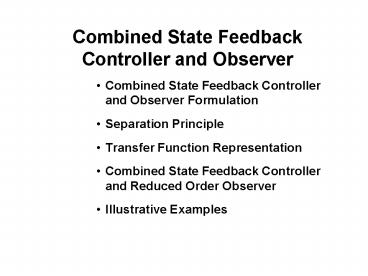Combined State Feedback Controller and Observer PowerPoint PPT Presentation
1 / 29
Title: Combined State Feedback Controller and Observer
1
Combined State Feedback Controller and Observer
- Combined State Feedback Controller and Observer
Formulation - Separation Principle
- Transfer Function Representation
- Combined State Feedback Controller and Reduced
Order Observer - Illustrative Examples
2
Motivation
- In most control applications all state variables
are not measurable - A full or reduced order observer may be used to
estimate needed states - Separation principle allows independent
controller and observer design
3
Combined Controller-Observer Formulation
Plant
Controller
Observer
4
State Feedback Observer Block Diagram
u
y
r
System
L
x
y
z-1
C
H
Observer
G
-K
5
Closed-Loop System
Closed-Loop Control Subsystem
Closed-Loop Observer Subsystem
Overall Closed-Loop System
6
Separation Principle
Eigenvalues of the closed loop systems are the
union of eigenvalues of
- Closed-loop poles, i.e., eigenvalues of G-HK and
- Observer poles GA-LC
7
Separation Principle--Transfer Function
Closed-Loop System Laplace Transform
Closed-loop transfer function
- Closed-loop transfer function is the same as full
state feedback - Observer dynamics are canceled
8
Laplace Domain Representation
Plant
Controller
Observer
Laplace Transform of Observer
Controller in z-domain
9
Transfer Function Block Digaram Representation
Control Input
Solving for U gives
where
Y
R
G
F1
F2
10
D.C. Motor Example
Consider a d.c. servomotor system given by the
transfer function y position output u input
voltage the motor. Motor parameters k/J1 and
b/J5.
11
Feedback Control Design for D.C. Motor Example
Desired Closed-Loop System damping ratio ?0.8
and natural frequency ?n500 rad/sec (less than
3 maximum overshoot and settling time of 0.01
sec.)
System in Controllable Form
Control gain
12
Servo Example Observer Design
Observer Dynamics (2 times faster than
controller) ?0.8 and ?n1000 rad/sec
Observer gain
Observer State Equations
13
Equivalent Transfer Function of Servo Example
Feedback and Feedforward Block
where
14
Closed-Loop Transfer Function
R
G
F1
F2
Pole-zero Cancellation
15
Combined Controller Reduced Order Observer (CCRO)
Plant State Equation
Reduced Order Observer
16
Transfer Function Representation of CCRO
Partition State Feedback Gain
Reduced Order Observer Transfer Function
Substitute Z in Control Law
where
17
Transfer Function Block Digaram Representation of
CCRO
Y
R
G
F1
F2
F1 and F2 are of order n-q (lower than FOO)
18
D.C. Motor Example
19
Closed-Loop System of CCRO Example
20
Matlab Solution
Simulation Example of Combined
Observer System G(s)b/(s2bs) Observable
form dx1/dtx2, dx2/dt-ax2bu System
Matrices b1 a5 A0 10 -a B0b C1
0 D0 plantss(A,B,C,D)
21
MATLAB Example Control Design
Control Design desired closed-loop damping and
natural frequency zeta0.8 wn500 pd-zetawnsq
rt(zeta2-1)wn desired closed-loop
poles Ackermans's formula to find
gain Kacker(A,B,pdconj(pd))
22
MATLAB Example FOO Design
Full-order observer r2 pdo-rzetawnrsqrt(z
eta2-1)wn desired observer poles L(acker(A',C
',pdoconj(pdo)))' AoA-LC ffss(Ao,B,K,0)
Part of feedforward block fbss(Ao,L,K,0)
Feedback Block g-(K/Ao)L
23
MATLAB Example ROO Design
Reduced-order observer pr-rwn A11A(1,1)
A12A(1,2) B1B(1) A21A(2,1) A22A(2,2)
B2B(2) K1K(1) K2K(2) Lr(A22-pr)/A12 ArA22
-LrA12 ByA21-LrA11ArLr BuB2-LrB1 ffrss(
Ar,Bu,K2,0) fbrss(Ar,By,K2,K1K2Lr) gr-(K2/Ar
)ByK1K2Lr
24
Simulink Block Diagram
25
Simulation Parameters
Slow Observers r0.5, Fast Observers
r5 Mismatch b1.5 Random input and measurement
noise
26
Slow Observer Plots
FOO,ROO
27
Fast Observer Plots
FOO,ROO
28
Comments on Simulation Results
- Slow ROO performs better than slow FOO
- High speed ROO and FOO are similar
29
End of Lecture 18
Next Lecture Optimal Control

